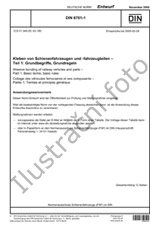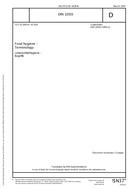Potřebujeme váš souhlas k využití jednotlivých dat, aby se vám mimo jiné mohly ukazovat informace týkající se vašich zájmů. Souhlas udělíte kliknutím na tlačítko „OK“.
ASTM F1736-09
Standard Guide for Irradiation of Finfish and Aquatic Invertebrates Used as Food to Control Pathogens and Spoilage Microorganisms
Automaticky přeložený název:
Standardní Příručka pro ozařování ryb a vodních bezobratlých používají jako potraviny v řídících patogenů a znehodnocením mikroorganismů
NORMA vydána dne 1.2.2009
Informace o normě:
Označení normy: ASTM F1736-09
Poznámka: NEPLATNÁ
Datum vydání normy: 1.2.2009
Kód zboží: NS-51353
Počet stran: 6
Přibližná hmotnost: 18 g (0.04 liber)
Země: Americká technická norma
Kategorie: Technické normy ASTM
Kategorie - podobné normy:
Anotace textu normy ASTM F1736-09 :
Keywords:
aquatic invertebrates, bacteria, crustacea, echinoderms, finfish, irradiation, labeling, microorganisms, molluscs, packaging, parasites, pathogens, processing, shellfish, Parasites, Pathogens, Shellfish, Bacteria/bacterial control, Crustacea, Finfish, Food irradiation, Labels/labeling, Microorganisms, Packing/packaging materials/systems (food), ICS Number Code 67.020 (Processes in the food industry)
Doplňující informace
| Significance and Use | ||||||||||||||
|
Absorbed doses of or below 1 kGy can inactivate some parasites, such as the broad fish tapeworm (Dibothrocephalus latus) (2). Absorbed doses below 10 kGy can reduce or eliminate vegetative cells of pathogenic sporeforming and non-sporeforming microorganisms, such as Clostridia spp., Vibrio spp., Salmonellae, Listeria monocytogenes, or Staphylococcus aureus, that may be present in fresh or frozen product. Absorbed doses below 10 kGy can reduce the numbers of some spores, but are not adequate to reduce the potential health risk from microbial spores or toxins (3). Absorbed doses below 10 kGy can reduce or eliminate the vegetative cells of sporeforming and non-sporeforming microorganisms, such as Bacillus or Pseudomonas species, that cause spoilage of fresh product, thus extending refrigerated shelf life in many cases (4). |
||||||||||||||
| 1. Scope | ||||||||||||||
|
1.1 This guide outlines procedures and operations for the irradiation of raw, untreated, fresh (chilled), or frozen finfish and aquatic invertebrates, while ensuring that the irradiated product is safe and wholesome. 1.1.1 Aquatic invertebrates include molluscs, crustacea, echinoderms, etc. 1.1.1.1 Molluscs include bivalve shellfish, such as clams, mussels, and oysters; snails; and cephalopods, such as squid and octopus. 1.1.1.2 Crustacea include shellfish such as shrimp, lobster, crabs, prawns and crayfish. 1.1.1.3 Echinoderms include sea urchins and sea cucumbers. 1.2 This guide covers absorbed doses used to reduce the microbial and parasite populations in aquatic invertebrates and finfish. Such doses typically are below 10 kGy (1). 1.3 The use of reduced-oxygen packaging (vacuum or modified atmosphere, and including products packed in oil) with irradiated, raw product is not covered by this guide. The anaerobic environment created by reduced-oxygen packaging provides the potential for outgrowth of, and toxin production from, Clostridium botulinum spores. 1.4 This guide does not cover the irradiation of smoked or dried fish to reduce microbial load or to control insect infestation. 1.5 The values stated in SI units are to be regarded as standard. No other units of measurement are included in this standard. 1.6 This standard does not purport to address all of the safety concerns, if any, associated with its use. It is the responsibility of the user of this standard to establish appropriate safety and health practices and determine the applicability of regulatory requirements prior to use. |
||||||||||||||
| 2. Referenced Documents | ||||||||||||||
|
Podobné normy:
1.5.2014
1.5.2014
NEPLATNÁ
1.7.2000
NEPLATNÁ
1.3.2007
NEPLATNÁ
1.3.2012
1.11.2006



 DIN 10502-1:2014-05..
DIN 10502-1:2014-05.. DIN 10503:2007-03..
DIN 10503:2007-03.. DIN 10507:2006-11..
DIN 10507:2006-11..
 Cookies
Cookies
